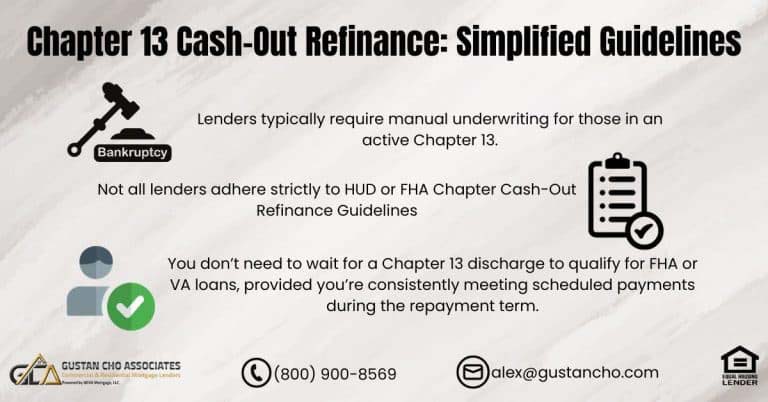In this blog, we will cover and discuss USDA loan after Chapter 7 Bankruptcy mortgage guidelines for first-time homebuyers. USDA lending guidelines for first-time homebuyers allow buyers to purchase a home with no money down and 100% financing. Dale Elenteny, a senior mortgage loan originator at Gustan Cho Associates says the following about getting approved for USDA loan after Chapter 7 Bankruptcy.
Per USDA Lending Guidelines, not all areas are eligible for USDA loans. The U.S. Department of Rural Development, a government agency, is in charge of USDA lending guidelines.
There are maximum household requirements per USDA lending guidelines. USDA lending guidelines require that the area be designated as USDA Rural Development approved for homes to qualify for this government loan program. Homebuyers can qualify for USDA loan after Chapter 7 Bankruptcy after three years from the discharge date. In the following paragraphs, we will cover qualifying for a USDA loan after Chapter 7 Bankruptcy.
USDA Loan After Chapter 7 Bankruptcy Eligibility Requirements
USDA loans are government-backed loans that is a great loan program for those who qualify. The difference between USDA versus other loan programs is that the property needs to be located in a USDA Designated Rural Area. John Strange, a senior mortgage loan originator at Gustan Cho Associates says the following about USDA loan after Chapter 7 Bankruptcy:
USDA loan program requires borrowers to meet household income requirements. USDA mortgage guidelines are designed for homebuyers with moderate income.
The program allows families with moderate to lower income to qualify to purchase a home with no down payment and 100% financing. There is a three year waiting period to qualify for USDA loan after Chapter 7 Bankruptcy.
Can I get a USDA loan after Chapter 7 bankruptcy?
Yes—typically after a 3-year waiting period, depending on circumstances.
USDA Property Eligibility
An eligible area is defined by USDA is an area that is either located in a rural area and/or close by a rural area. Many counties in the United States are designated rural areas by USDA.
Get the USDA loan after Chapter 7 bankruptcy mortgage guidelines right here. Learn waiting times, credit score rules, and how to qualify at Gustan Cho Associates.
There are maximum loan limits on USDA loans. The USDA property eligibility tool is the link to all eligible areas in the U.S. where homebuyers can purchase homes if they qualify for USDA loans. Gustan Cho Associates are mortgage brokers with dozens of wholesale lenders with no overlays on USDA loans.
USDA Lending Guidelines on Income Requirements
The single-family housing program link for USDA home loans will state the income eligibility requirements for borrowers to qualify. The agency uses several factors in determining qualified income for borrowers to qualify.
Property location and zip code the subject property is located. This includes the county and state and neighboring areas. The number of people in the household under 18 years old.
The number of people in the household who are handicapped and not able to work and the number of full-time students. Age of borrowers and/or co-borrowers. Preference is given to 62-year-old and older borrowers.
Household Expenses Are Taken Into Account on USDA Loans
Household expenses in the household such as medical care, child care, senior care, and total household income. The income of the non-borrowing spouse is taken into consideration. In the following paragraphs, we will cover and discuss the credit and income guidelines to qualify for USDA loans with 100% financing.
Credit and Income USDA Mortgage Lending Guidelines
Many lenders will require a 620 to 640 credit score on USDA loans. However, Gustan Cho Associates can approve borrowers with 580 credit scores. The minimum credit score of 580 FICO. Max debt to income ratios per the Guaranteed Underwriting System (GUS) which is the Automated Underwriting System used on automated approvals on USDA loans. 31% front end and 41% back end debt to income ratios. Borrowers with under 580 credit scores can qualify with compensating facts
GUS Automated Underwriting System
AUS Findings will render an approve/eligible, refer/eligible, or refer/caution. Approve/Eligible is what borrowers would need for lenders to proceed with the mortgage process. The automated Underwriting System will determine automated findings after analyzing credit, capacity, and collateral.
How About Closing Closing Costs
There is no down payment on home purchase on USDA loans. However, all mortgage transactions have closing costs. Homebuyers do not have to worry about coming up with closing costs on a home purchase. The team at Gustan Cho Associates will help borrowers negotiate a seller concession by home sellers.
USDA allows up to 6% seller concessions by sellers to cover homebuyers’ closing costs. If buyers are short of closing costs with seller concessions, lenders can offer lender credit with a lender credit.
First time home buyers should enroll in a first-time homebuyer course. Buyers can use this link MGIC Homebuyer Education or similar housing course to learn more about becoming a first-time homebuyer.
We Approve Borrowers Other Lenders Deny
Even after bankruptcy, we have no-overlay USDA loan solutions.
USDA Loan After Chapter 7 Bankruptcy With Bad Credit
Borrowers can qualify for USDA home loans after bankruptcy, foreclosure, deed in lieu of foreclosure, short sale, and prior bad credit. Prior bad credit is fine but lenders want to see timely payments in the past 12 months.
Most lenders do not want to see any late payments after bankruptcy and/or foreclosure. There is a three-year waiting period after the Chapter 7 Bankruptcy discharge date.
There is a 3-year waiting period after the recorded date of foreclosure, deed in lieu of foreclosure, and short sale. Prior outstanding collections and charged-off accounts are fine as long as the automated underwriting system approves it. Borrowers who need to qualify for USDA loans with a lender with no overlays on government and conventional loans.
USDA Loan After Chapter 7 Bankruptcy Waiting Period Requirements
The United States Department of Agriculture Rural Development, also known as USDA Rural Development, offers residential mortgage loan programs that require no down payment to home buyers after bankruptcy and bad credit.
There is a three-year waiting period after the Chapter 7 Bankruptcy discharge date to qualify for USDA loan after Chapter 7 Bankruptcy. Offers 100% financing on residential mortgage loans on select areas.
Borrowers meets USDA mortgage guidelines. USDA loan program offers competitive mortgage rates due to government guaranteeing lenders in the event borrowers default and property goes into foreclosure. In the following paragraphs, we will discuss and cover USDA mortgage guidelines and eligibility requirements.
Types of USDA Loan Programs
In this paragraph, we will discuss the USDA Guaranteed Home Loan and USDA Mortgage Guidelines. The USDA RD Guaranteed Loan Program is the more common USDA loan program. This is due to the fact that it allows borrowers who have average to higher incomes to get USDA approvals with 100% financing with no money down. Borrowers who apply for the USDA Guarantee Loan program are eligible with taxable income of up to 115% of the household median income of the population of their county. All USDA mortgage loans are 30 year fixed rate loans.
Benefits of Getting a USDA Loan.
USDA Direct Home Loan is a great mortgage option for homebuyers in rural areas. USDA RD Direct Mortgage Loans are given on a selected basis than the traditional more popular USDA guaranteed mortgage loans. USDA RD Direct Mortgage loans have been created to help lower-income families get 100% financing with no money down. Borrowers and property need to meet USDA mortgage guidelines.
USDA Loan After Chapter 7 Bankruptcy Versus Other Loan Programs
There are many advantages of USDA loan programs. USDA Loan programs home buyers an opportunity to purchase a home at a selected area with zero down payment.
Many times homebuyers’ monthly housing payments on a USDA loan are less than their actual current rental payments. Plus the USDA loan homeowner has great potential in having their homes appreciate in value over the years.
USDA loans have tougher lending guidelines than FHA loans. For example, to qualify for an FHA loan, the borrower only needs a 580 credit score. Most USDA lenders require a credit score of 640 or higher due to lender overlays. Gustan Cho Associates has no overlays on USDA Home Loans. USDA loan after Chapter 7 Bankruptcy is a three-year waiting period versus FHA and VA loan’s two-year waiting period.
Do I need perfect credit after Chapter 7 for USDA?
No—USDA allows flexible credit and no overlays with the right lender.
USDA Mortgage Guidelines on Debt To Income Ratio
The debt-to-income ratios caps on FHA loans are 46.9% front-end and 56.9% back-end debt-to-income ratios. With USDA loans, the maximum debt to income ratio is capped at 29% front-end and 41% back-end debt to income ratio.
USDA loan programs are the only residential loan program in the United States, with the exception of VA loans, that first-time homebuyers or homebuyers can purchase a home with no money down.
There is a 2% funding fee that is charged on each USDA loan. But the funding fee can be rolled into the USDA loan balance.
USDA Loan Qualification Requirement
USDA loans are not available for everyone and are not available in all areas. The region where the home is located needs to be a USDA-approved area in order for the property to qualify for a USDA loan.
The home buyer also needs to meet the minimum USDA mortgage guidelines. The home buyer’s income, credit, and liabilities will be determining considerations for qualifying for USDA Loan eligibility requirements.
To determine whether a home buyer meets USDA loan qualification minimum requirements, the homeowner’s housing expenses cannot surpass a 29% debt to income ratios cap. The back-end debt to income ratio cap is set at 41%. These ratios can be exceeded if compensating factors exist for the mortgage loan borrower. Compensating factors are like rental verification, reserves, and higher credit scores.
Income Requirements on USDA Loans
USDA Loan program mortgage loan borrowers can get qualified for a USDA loan with incomes up to 115% of the area median income. Those with super high incomes are not eligible for USDA loan programs. USDA lenders require a minimum credit score of 580 to be able to qualify for a USDA loan.
Most USDA lenders do have credit score minimum overlays of 620 or 640 credit scores not because of USDA Mortgage Guidelines but because of their overlays on credit scores.
To qualify for a USDA loan, the borrower’s income must be at or below the maximum allowed per USDA income set limits for the geographical area the subject property is located.
Types of Properties Eligible For USDA Loans
To be eligible for a USDA loan, homebuyers must purchase owner-occupant homes. Homebuyers cannot purchase a second home, vacation home, or investment home with a USDA loan. Buyers can purchase, new homes, existing older homes, condominiums, and new manufactured homes with USDA loans.
USDA Loan After Chapter 7 Bankruptcy Mortgage Guidelines
Get the USDA loan after Chapter 7 bankruptcy mortgage guidelines right here. Learn waiting times, credit score rules, and how to qualify at Gustan Cho Associates.
Understanding USDA Loan After Chapter 7 Bankruptcy Mortgage Guidelines
Buying a home after a Chapter 7 bankruptcy can feel impossible, yet thousands of families succeed each year. You’re on the right track if you’re considering a USDA loan after Chapter 7 bankruptcy. USDA loans are backed by the USA Department of Agriculture, these loans let approved buyers in service areas get a mortgage with no money down.
At Gustan Cho Associates, we’re experts in rural loans. Unlike most lenders, we don’t add extra rules (called overlays) to USDA policies. When you talk to us, you get only the official guidelines and a clear path to approval.
USDA Loan Basics for Borrowers After Bankruptcy
What Is a USDA Loan?
A USDA loan is a mortgage guaranteed by the government that helps families with lower to moderate incomes buy homes in eligible rural areas. The program is great because it offers:
- 0% down payment, so you can buy without saving a huge sum first.
- Low fixed interest rates that won’t change over the life of the loan.
- Flexible credit requirements that understand past financial hiccups.
- Reduced mortgage insurance compared to what FHA loans charge.
USDA Loan Waiting Period After Chapter 7 Bankruptcy
Standard Waiting Period
- After a Chapter 7 bankruptcy, the USDA usually requests a 3-year waiting period from when the bankruptcy is discharged.
- Ensure you count the time from when you get your discharge papers, not when you file the case.
- Use this time to build a solid credit history and show that your finances are back on track.
Possible Exceptions
Sometimes, the USDA can grant a loan with less than the typical 3-year wait if you can prove that a real-life crisis—like losing a job, serious health issues, or a divorce—forced the bankruptcy. You must supply paperwork showing a steady income and evidence of recovery since the bankruptcy.
USDA Loan Credit Guidelines After Chapter 7
Minimum Credit Scores
The USDA doesn’t publish a strict credit score rule, but most lenders want to see a score in the 580 to 640 range for loans to get through easily. At Gustan Cho Associates, our team often approves loans even when a borrower’s credit score is below the normal cutoff for traditional lenders.
Re-establishing Credit
To qualify for a USDA loan after a Chapter 7 bankruptcy, applicants should:
- Pay all bills on time.
- Open new secured credit cards or take small installment loans to rebuild.
- Dodge fresh late payments, avoid collections, and keep credit usage low.
USDA Income and Property Guidelines After Bankruptcy
Income Requirements
- Total household income must stay below USDA county income limits (typically 115% of area median income).
- USDA counts everyone in the household, not just the loan applicant.
Bankruptcy Doesn’t Mean No Home
USDA loans give credit-challenged buyers a path to homeownership.
Property Requirements
- Home must sit in a USDA-eligible rural area.
- Property must be safe, sanitary, and modest—no huge homes or luxury upgrades.
- USDA loans cannot be used for investment homes or vacation properties.
How Gustan Cho Associates Helps With USDA Loans After Bankruptcy
We have no lender overlays, so:
- We only apply the USDA’s official rules.
- We say “yes” when most lenders say “no.”
- We write loans in 48 states and Washington, D.C.
- If you received a “no” elsewhere, let us review your case and help you reach the finish line.
Steps to Qualify for a USDA Loan After Chapter 7
Step 1: Check Your Bankruptcy Discharge Date.
- First, confirm that at least 3 years have passed since your Chapter 7 discharge, unless you have special circumstances.
Step 2: Review Credit and Income
- Get your free credit report.
- Collect recent pay stubs, W-2s, and the last 2 years of tax returns.
Step 3: Find a USDA Eligible Property
- Partner with our team to use the USDA eligibility map and find a qualifying home that fits your budget.
Step 4: Apply With Gustan Cho Associates
- Start your application today.
- Our team will support you from pre-approval all the way to closing.
Alternatives If You Don’t Meet USDA Guidelines Yet
- FHA Loan After Chapter 7 – wait just 2 years post-discharge.
- VA Loan After Chapter 7 – veterans and active-duty members may qualify after a 2-year wait.
- Non-QM Loans – these work for borrowers who can’t yet meet agency standards, with no required waiting period.
Frequently Asked Questions (FAQs)
How soon after Chapter 7 can I get a USDA loan?
- Typically, you must wait 3 years from the discharge date.
Can I get a USDA loan with a credit score under 640?
- Yes, but you will need stronger compensating factors, such as a low debt-to-income ratio.
What counts as a valid reason to speed up the USDA wait?
A serious health issue, a significant natural disaster, or a job loss you didn’t see coming may allow you to get an exception.
Does the USDA look at my spouse’s income if they’re not on the loan?
- Yes, the USDA counts everyone’s total income in the household.
Can I buy a second home with a USDA loan?
- USDA loans are for your single, primary place to live, not a vacation home.
Will a bankruptcy prevent me from ever getting a mortgage?
- Not at all.
- You can own a home again with the USDA program and proper advice.
What’s the required down payment for a USDA loan?
- There’s no down payment required. It’s a zero down mortgage.
Will my interest rates go up after bankruptcy?
- Interest rates depend on the current market and your credit score, not just your bankruptcy history.
Can I refinance my USDA loan in the future?
- Yes, USDA provides streamlined refinance options to lower your rate or monthly payments.
Why pick Gustan Cho Associates for my USDA loan?
- We specialize in tough cases that others won’t touch.
- We have no extra rules and know USDA regulations inside and out.
Call us at 800-900-8569 or text us for a faster response. You can also email us at gcho@gustancho.com to find out if you can get a USDA loan just after a Chapter 7 bankruptcy.
Qualifying For USDA Mortgage Loans With Direct Lender With No Overlays
Gustan Cho Associates is a national mortgage company with zero lender overlays on USDA loans. To qualify for USDA loans with a lender with no mortgage overlays on government and conventional loans, please contact us at Gustan Cho Associates at 800-900-8569 or text us for a faster response. Or email us at gcho@gustancho.com. We are available 7 days a week, on evenings, weekends, and holidays.
Do I need perfect credit after Chapter 7 for USDA?
No—USDA allows flexible credit and no overlays with the right lender.









